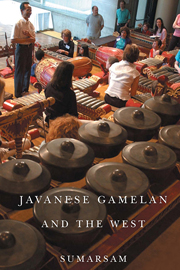Book contents
- Frontmatter
- Contents
- List of Illustrations
- Preface
- Acknowledgments
- Note on Orthography
- Introduction
- Part One Hybridity in Javanese Performing Arts
- Part Two Gamelan as Intercultural Object
- 4 Deterritorializing and Appropriating Gamelan
- 5 Cross-Cultural Perspectives on Gamelan Theory: Metaphorical Readings of Gamelan
- Conclusion
- Notes
- Glossary
- Selected Discography
- Bibliography
- Index
4 - Deterritorializing and Appropriating Gamelan
from Part Two - Gamelan as Intercultural Object
Published online by Cambridge University Press: 05 September 2013
- Frontmatter
- Contents
- List of Illustrations
- Preface
- Acknowledgments
- Note on Orthography
- Introduction
- Part One Hybridity in Javanese Performing Arts
- Part Two Gamelan as Intercultural Object
- 4 Deterritorializing and Appropriating Gamelan
- 5 Cross-Cultural Perspectives on Gamelan Theory: Metaphorical Readings of Gamelan
- Conclusion
- Notes
- Glossary
- Selected Discography
- Bibliography
- Index
Summary
Sir Thomas Stamford Raffles, British colonial governor of Java from 1813 to 1816, published The History of Java in 1817. This two-volume work contains a rich discourse on many aspects of Javanese life, complete with many lavish illustrations. The book celebrates Java for its pomp and glory, incorporating descriptions of court life, the royal family, performing arts, weaponry, architecture, antiquities, the life of the commoners, the animal kingdom, and more.
It is commonly held that Raffles's book is inextricably linked to his political goals. As James Boon suggests, the book “is designed to convey in print and illustration a concrete model of his policies' ideals, a portrait of the wonder that Java promised, had his administration endured.” Anthony Forge confirms this line of thought in his study of the book's illustrations. Analyzing the color plates, he asserts that six of them “are in twisted perspective, the heads being shown in profile, the bodies more or less full on and the legs and feet again in side view, moving to the left or right. At first sight this suggests Javanese work, as these conventions are characteristic of wayang kulit yet to me these drawings do not feel Javanese at all.” After examining several other drawings, Forge concludes: “Raffles used his illustrations to reduce facile exoticism and present the Javanese as ‘civilized’ in a European sense.” He goes on to argue that “Rafles's visual material can be said to have minimized, almost domesticated, the genuine ‘exoticness’ of Java.
- Type
- Chapter
- Information
- Javanese Gamelan and the West , pp. 77 - 114Publisher: Boydell & BrewerPrint publication year: 2013



